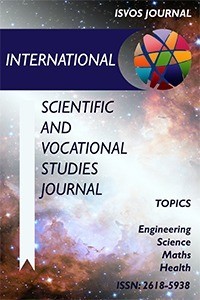Investigation of Global Warming Case of Antalya
Global warming, trend analysis, Mann Kendall rank correlation test, Antalya.”
Investigation of Global Warming Case of Antalya
Global Warming, Trend Analysis, Mann Kendall Rank Correlation Test, Antalya. Global warming, trend analysis, Mann Kendall rank correlation test, Antalya.”,
___
- [1] V. A., Steinke, LA., Martins Palhares de Melo, M., Luiz Melo, R., Rodrigues da Franca, R., Luna Lucena, E., Torres Steinke, E., “Trend analysis of air temperature in the federal district of Brazil: 1980–2010”, Climate, 2020, doi: 10.3390/cli8080089.
- [2] J., Tian, J., Liu, J., Wang, C., Li, H., Nie, F., Yu, “Trend analysis of temperature and precipitation extremes in major grain producing area of China”, International Journal of Climatology, 2017, doi: 10.1002/joc.4732.
- [3] D., Fenner F, Meier D, Scherer A, Polze A., “ Spatial and temporal air temperature variability in Berlin, Germany, during the years 2001-2010”, Urban Climate, 2014, doi: 10.1016/j.uclim.2014.02.004.
- [4] R., Saboohi, S., Soltani, M., Khodagholi, “Trend analysis of temperature parameters in Iran, Theoretical and Applied” Climatology, 2012, doi: 10.1007/s00704-012-0590-5.
- [5] I., Ahmad, S., Zhaobo, D., Weitao, R., Ambreen, “Trend analysis of January temperature in Pakistan over the period of 1961-2006: Geographical Perspective”, Pakistan Journal of Meteorology, Vol. 7, no. 13, pp. 11-22, 2010.
- [6] A., Toreti, F., Desiato, “Temperature trend over Italy from 1961 to 2004”, Theoretical and Applied Climatology, 2008, doi: 10.1007/s00704-006-0289-6.
- [7] M., Domroes, A., El‐Tantawi, “Recent temporal and spatial temperature changes in Egypt”, International Journal of Climatology: A Journal of the Royal Meteorological Society, 2005, doi: 10.1002/joc.1114.
- [8] M. I., Chidean j, Muñoz-Bulnes J, RamiroBargueño A. J., Caamaño S, Salcedo-Sanz S., “Spatio-temporal trend analysis of air temperature in Europe and Western Asia using data-coupled clustering”, Global and Planetary Change, 2015, doi: 10.1016/j.gloplacha.2015.03.006.
- [9] S. A., Salman, S., Shahida, T., Ismail, E., Chung, A. M., Al-Abadic, “Long-term trends in daily temperature extremes in Iraq”, Atmospheric Research, vol. 198, no. 1, pp. 97-107, 2017.
- [10] M., Karabulut, “Doğu Akdeniz’de ekstrem maksimum ve minimum sıcaklıkların trend analizi”, KSÜ Doğa Bilimleri Dergisi, Özel Sayı, pp. 37-44, 2012.
- [11] Y., Kızılelma, M., Çelik, M., Karabulut, “İç Anadolu Bölgesinde sıcaklık ve yağışların trend analizi”, Türk Coğrafya Dergisi, vol. 64, pp. 1-10, 2015.
- [12] E., Macana, E., Yeşilırmak, E., “Büyük Menderes Havzasında Ortalama, Maksimum Ve Minimum Sıcaklık Eğilimleri”, Journal of Adnan Menderes University Agricultural Faculty, vol. 12, no 1, pp. 73 – 80, 2015.
- [13] S., Tokgöz, t., Partal, “Karadeniz Bölgesinde Yıllık Yağış ve Sıcaklık Verilerinin Yenilikçi Şen ve Mann-Kendall Yöntemleri ile Trend Analizi”, Iğdır Üniversitesi Fen Bilimleri Enstitüsü Dergisi, vol. 10, no. 2, pp. 1107-1118, 2020.
- [14] F., Cosun, m., Karabulut, “Kahramanmaraş’ta ortalama, minimum ve maksimum sıcaklıkların trend analizi” Türk Coğrafya Dergisi, vol. 53, pp. 41-50, 2009.
- [15] A. D., Demir, Y., Demir, Ü., Şahin, R., Meral, “Bingöl İlinde Sıcaklık ve Yağışların Trend Analizi ve Tarıma Etkisi”, Türk Tarım ve Doğa Bilimleri Dergisi, vol. 4, no. 3, pp. 284-291, 2017.
- [16] K. Saplıoğlu, M., Kilit, M., “İklim Değişikliğinin Afyon İlindeki Yağış ve Sıcaklıklara Etkisinin Araştırılması ve Trendlerinin Belirlenmesi”, Engineering Sciences , vol. 7 , no. 4 , pp., 696-705, 2012.
- [17] P., Polat, M., Sunkar, “Rize’nin iklim özellikleri ve Rize çevresinde uzun dönem sıcaklık ve yağış verilerinin trend analizleri”, Fırat Üniversitesi Sosyal Bilimler Dergisi, 2017, doi: 10.18069/firatsbed.346684.
- [18] A. Ülke, T., Özkoca, “Sinop, Ordu ve Samsun illerinin sıcaklık verilerinde trend analizi”, Gümüşhane Üniversitesi Fen Bilimleri Enstitüsü Dergisi, doi: 10.17714/gumusfenbil.351294, 2018.
- [19] D. R., HELSEL, R.M., HIRSCH, Statistical Methods in Water Resources, Elsevier, New York, USA, 1992.
- ISSN: 2618-5938
- Yayın Aralığı: Yılda 2 Sayı
- Başlangıç: 2017
- Yayıncı: Umut SARAY
Munise Didem DEMİRBAŞ, Didem ÇAKIR (SOFUOĞLU)
Runge Kutta Optimization for Fixed Size Multimodal Test Functions
Fatih CANTAŞ, Serdar ÖZYÖN, Celal YAŞAR
Ayşe Nur OYMAK SOYSAL, Şule ŞİMŞEK, Atiye KAŞ ÖZDEMİR, Şule FIRINCI
Applicability Of Incineration Technology In Waste Management: Istanbul Case Study
Mehmet TAŞTAN, Mehmet Nurettin UĞURAL
Experimental Analysis of Pneumatic Motion Control Application with Piezo Technology
Çiğdem GÜNDOĞAN TÜRKER, Fikret AKYÜZ
Coping Methods Used by Students of a Health School for Dysmenorrhea Management
Özgür ALPARSLAN, Dilek ÖCALAN, Funda DEMİRTÜRK
Ahmet TOLUNAY, Mustafa MALKOÇ, Mehmet ÖZMIŞ
The Effect of Fear of COVID-19 on Demonstrating Personal Health Behavior and Prosocial Behavior
